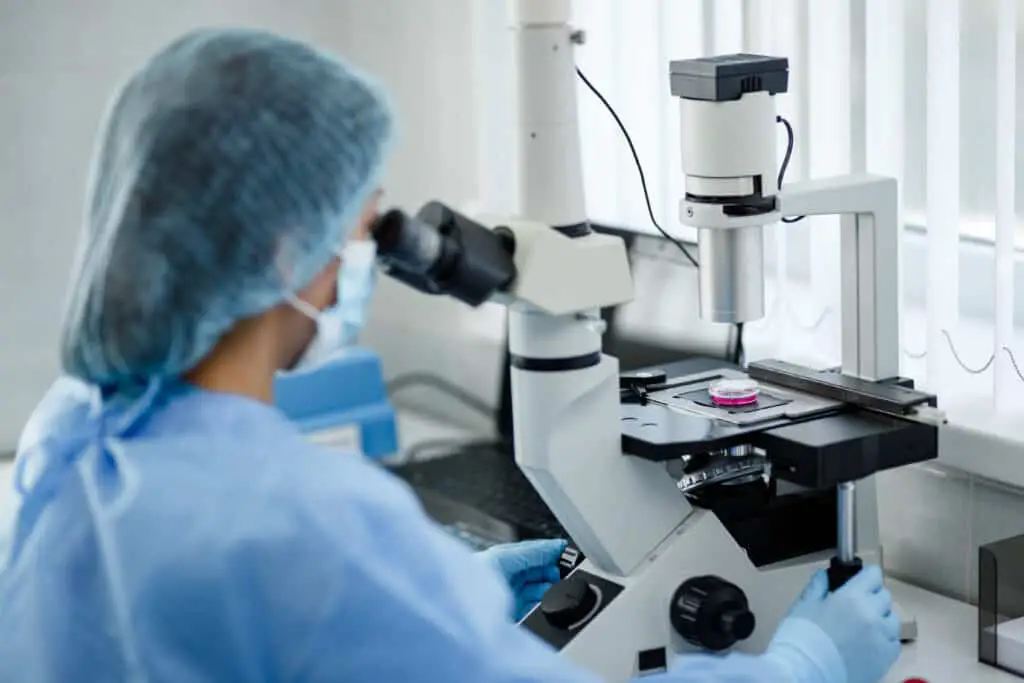Are you interested in microscopes and looking into purchasing one? Before going into your purchase, it is important to do your research on which microscope is best for the specific purpose you plan to use it for. Infinity-corrected objectives have only recently been created and added to microscopes and you may be wondering what this means and if it’s necessary for your microscope.
An infinity-corrected objective is a system where a light beam coming from a specimen goes through the objective lens (and does not create an image) and comes out as an infinity parallel beam through the tube lens which then creates an intermediate image. Infinity corrected objective lenses are the industry standard now.
Microscope technology is constantly being progressed and refined. Let’s talk about how infinity-corrected objectives have changed microscopes and what it means for us now.
History and Creation of Infinity-Corrected Objectives
Before infinity-corrected objectives, there were only finite-corrected objectives. This means that all microscopes had fixed tube lengths. The infinity-correct objective was only created a few decades ago, so they are still relatively new.
In the 1930s, a German microscope manufacturing company, Reichert, began experimenting with infinity-corrected objectives and optical systems. Zeiss and Leica were the first followers of this new movement in microscope manufacturing. The infinity-corrected optical system became commonly used beginning in the 1980s.
How They are Different Than Previously Used Objectives

The main difference between the infinity-corrected objectives and the finite-corrected object is the tube length. Microscopes using the outdated method have a pre-determined and specified tube length. This means you cannot adjust the distance between the nosepiece where the objective is connected to where the ocular sits in the eyepiece.
With this added space, it allows light to be collected from the object itself and turned into parallel beams which will eventually pass through the tube lens. In the finite-correct objective, light is focused from the objective and into the focal plane where you can look. It creates parallel rays. This is a revolutionary discovery in the microscope community and for all those who use them.
Scientists are now able to insert polarizers, filters, illuminators, and wave-plates in between the eyepiece and the objective. This allows those who are using the microscope to more thoroughly examine the specimen. The Royal Microscopical Society had set the standard for microscope tube length at 160mm back in the nineteenth century. This standard length was accepted for over a century.
But in an infinity-corrected objective optical system, the tube lengths which are used today range from 160mm – 200mm. This tube length is also referred to as the focal length.
Below is a chart of some of the top microscope manufacturing companies that use infinity-corrected objective optical systems and their focal lengths.
| Microscope Manufacturing Company | Focal Length |
| Meiji | 200mm |
| Leica | 200mm |
| Nikon | 200mm |
| Olympus | 180mm |
| Zeiss | 165mm |
How Infinity-Corrected Objectives Are Used In Microscopes
Due to the ability to change the focal length, infinity-corrected objective optical systems are used for current-day research laboratory microscopes as well as industrial metallurgical microscopes. Microscopes with the improved objective have an image distance that has been set to infinity. To produce the intermediate image, a tube lens is placed within the body tube. This is placed between the objective and the eyepieces.
Auxiliary components such as illuminators and polarizers can be added in the parallel optical path in the infinity-corrected optical systems. These components can be added between the objective and tube lens with a minimal effect on focus. You can also add other components such as filters and wave-plates between the objective and where you look.
Benefits of Having Infinity Space in Your Microscope Objective
“Infinity Space” refers to the space between the objective and the lens on the tube. This provides a path of parallel light to an area where optical components can be placed. This is done without modification to the objective working distance or the introduction of spherical aberration.
While using infinity-corrected optics, one benefit is that the parfocality between the different objectives can be maintained, even when one or more auxiliary components are placed within the optical path. This is one of the biggest benefits of having one of these microscopes. You can continue viewing the specimen after you have placed additional filters or components on top.
These additional auxiliary components can help you to view the specimen more clearly and allow for a thorough examination of what you are looking at. With finite-corrected optics, you will not be able to do this. There is no light for you to see what is under the additional auxiliary component.
Another benefit of having the infinity space is that you can produce exactly 1x magnification without altering any settings of the microscope or the alignment between the spaces. This is done through accessories you can use with your microscope.
Even if you insert a parallel flat plate between the tube lens and the objective lens, the parfocal point will remain the same. This means there will be no shifting in the image.
Where To Purchase an Infinity-Corrected Objectives
Today you can buy microscopes that come with stock infinity corrected objective lenses. There are several great companies that sell just the infinity corrected objectives or entire microscopes that come with them. However if you have an Amazon account already set up there are several great buys i would suggest. I have posted a list below of infinity corrected objective lense for each magnification. They are some of the lower priced options from companies you have probably heard of.

